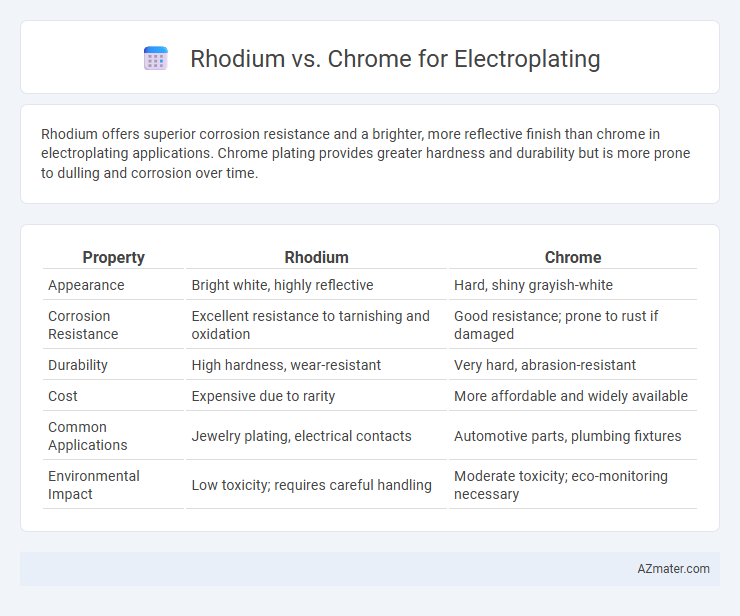Rhodium offers superior corrosion resistance and a brighter, more reflective finish than chrome in electroplating applications. Chrome plating provides greater hardness and durability but is more prone to dulling and corrosion over time.
Table of Comparison
| Property | Rhodium | Chrome |
|---|---|---|
| Appearance | Bright white, highly reflective | Hard, shiny grayish-white |
| Corrosion Resistance | Excellent resistance to tarnishing and oxidation | Good resistance; prone to rust if damaged |
| Durability | High hardness, wear-resistant | Very hard, abrasion-resistant |
| Cost | Expensive due to rarity | More affordable and widely available |
| Common Applications | Jewelry plating, electrical contacts | Automotive parts, plumbing fixtures |
| Environmental Impact | Low toxicity; requires careful handling | Moderate toxicity; eco-monitoring necessary |
Introduction to Electroplating
Electroplating involves depositing a thin metal layer onto a substrate using an electric current, enhancing surface properties such as corrosion resistance and aesthetic appeal. Rhodium and chrome are popular plating materials; rhodium offers superior hardness and a bright, reflective finish, making it ideal for jewelry, while chrome provides excellent durability and a corrosion-resistant, mirror-like surface commonly used in automotive and hardware applications. The choice between rhodium and chrome electroplating depends on factors like desired appearance, wear resistance, and application environment.
What is Rhodium Electroplating?
Rhodium electroplating involves applying a thin layer of rhodium, a rare and precious metal from the platinum group, onto a base metal to enhance durability, corrosion resistance, and aesthetic appeal. Compared to chrome plating, rhodium offers superior tarnish resistance and a brighter, whiter finish, making it highly popular for fine jewelry and high-end automotive trims. The electroplating process uses an electrolytic bath to deposit rhodium ions, resulting in a hard, reflective surface that significantly improves the longevity and visual quality of the plated item.
What is Chrome Electroplating?
Chrome electroplating involves depositing a thin layer of chromium onto a metal surface to enhance corrosion resistance, hardness, and aesthetic appeal. This process is widely used in automotive, plumbing, and decorative industries due to chromium's durability and bright, reflective finish. Compared to rhodium, chrome plating offers higher abrasion resistance and cost-effectiveness but is less effective in providing superior tarnish resistance and electrical conductivity.
Key Differences Between Rhodium and Chrome Plating
Rhodium plating offers superior reflectivity and corrosion resistance compared to chrome, making it ideal for fine jewelry and high-end decorative applications. Chrome plating excels in hardness and wear resistance, commonly used in automotive parts and industrial tools for long-lasting durability. While rhodium provides a brighter, more lustrous finish, chrome plating is preferred for its cost-effectiveness and ability to withstand harsh environmental conditions.
Aesthetic Appeal: Shine and Appearance
Rhodium plating offers a brilliant, mirror-like shine with a cool white finish that enhances jewelry and fine metal surfaces, making it highly desirable for a sleek, modern aesthetic. Chrome plating provides a highly reflective, polished surface with a slightly warmer tone, popular in automotive and industrial applications due to its durability and classic silver appearance. Both metals deliver excellent corrosion resistance and brightness, but rhodium's superior hardness and distinctive luster make it the preferred choice for luxury and high-end decorative electroplating.
Durability and Corrosion Resistance
Rhodium electroplating offers superior durability and exceptional corrosion resistance compared to chrome, making it ideal for fine jewelry and high-wear applications. Its dense, hard surface provides excellent protection against tarnishing and environmental damage over time. Chrome plating, while durable and corrosion-resistant, tends to be less resistant to scratches and chemical exposure than rhodium finishes.
Cost Comparison: Rhodium vs Chrome
Rhodium electroplating typically costs significantly more than chrome plating due to rhodium's rarity and higher market price, with rhodium priced around $10,000 per ounce compared to chrome's much lower commodity cost. Chrome plating offers an economical solution for corrosion resistance and aesthetic finish, making it a preferred choice for large-scale or budget-sensitive projects. The expense of rhodium plating is justified primarily in luxury applications requiring superior hardness, reflectivity, and tarnish resistance, where the premium cost aligns with enhanced performance and exclusivity.
Common Applications of Rhodium Plating
Rhodium plating is widely used in high-end jewelry, automotive parts, and electronics due to its exceptional corrosion resistance, hardness, and brilliant white finish. Unlike chrome, rhodium offers superior reflectivity and tarnish resistance, making it ideal for decorative and protective coatings on fine jewelry, musical instruments, and optical devices. Its applications extend to connectors and circuit boards where reliable conductivity and durability are critical.
Typical Uses of Chrome Plating
Chrome plating is widely used in automotive parts, such as bumpers and wheels, due to its excellent corrosion resistance and sleek, reflective finish. It is also common in industrial applications for tools and machinery components, providing durability and wear resistance under heavy use. Additionally, chrome plating is popular in household fixtures and decorative items, enhancing aesthetics while protecting against tarnish and wear.
Choosing the Right Plating for Your Needs
Rhodium plating offers a brilliant, highly reflective finish with exceptional corrosion resistance, making it ideal for fine jewelry and high-end decorative pieces requiring durability and enhanced aesthetics. Chrome plating provides a harder surface with excellent abrasion resistance and a sleek, industrial look, commonly used in automotive parts and hardware where wear and toughness are crucial. Selecting between rhodium and chrome depends on application needs: prioritize rhodium for superior shine and tarnish protection, or chrome for robust, long-lasting coatings suited to heavy use.

Infographic: Rhodium vs Chrome for Electroplating
 azmater.com
azmater.com